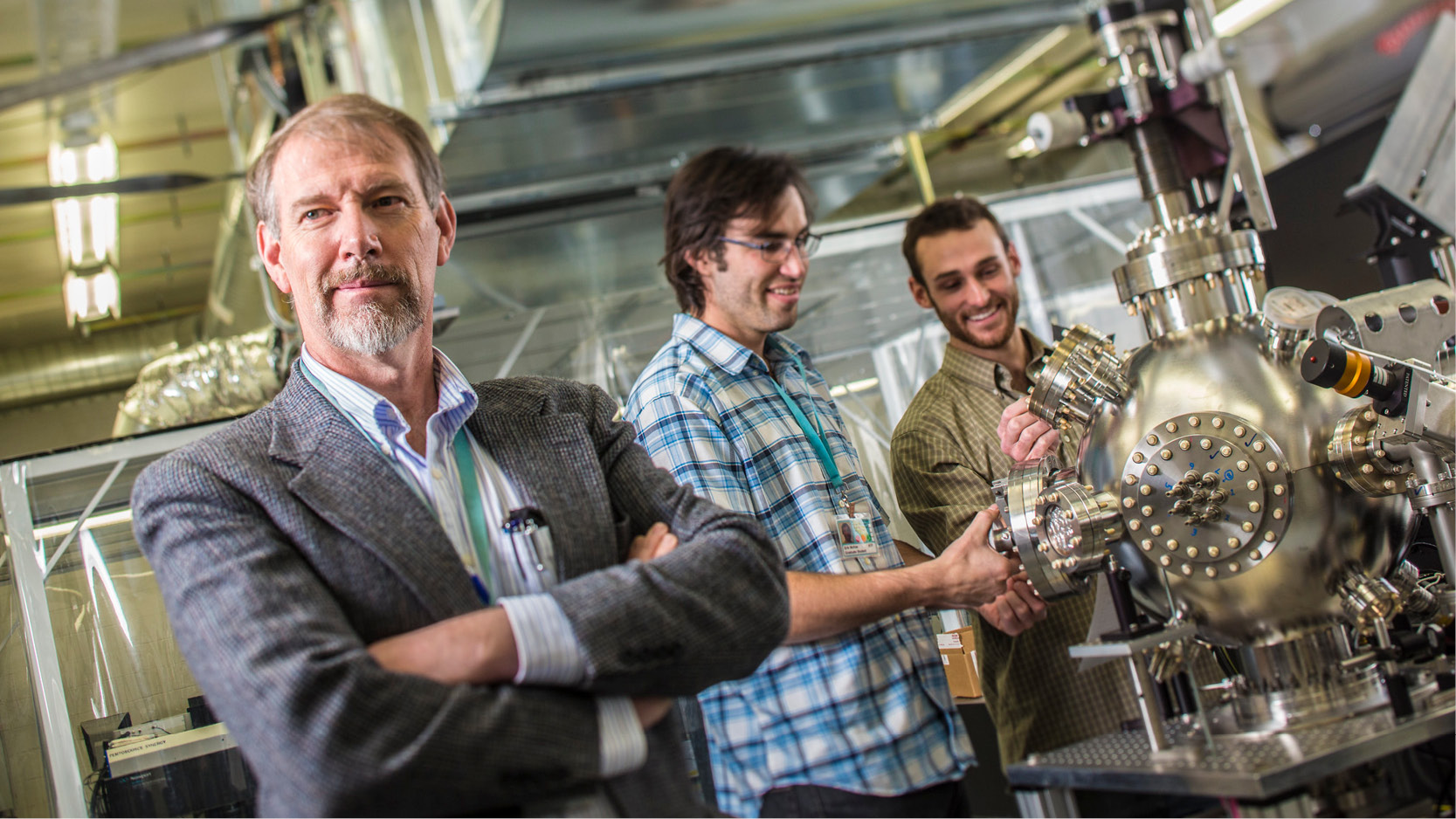Focused areas of research
The Department of Physics has identified the following topics as areas of specialty.
The Department of Physics is proud to offer an undergraduate minor in astronomy, as well as research opportunities using the department’s telescopes, spectrometer, and CCD camera. The Reno campus has long offered observing from the Planetarium and from Leifson Physics. In 2011, these resources were further augmented with the opening of the MacLean Observatory at the Redfield Campus in South Reno. The observatory features twin observing domes with 22-inch and 14-inch telescopes. We are also a partner institution of the 0.7 meter robotic Great Basin Observatory located in Great Basin National Park in Eastern Nevada (an International Dark Sky Park). This is the only research-grade telescope in a U.S. National Park. Undergraduate and graduate students also perform original research using ground-based radio telescopes (e.g., the Very Large Array) and space-based telescopes operated by NASA (e.g., the Chandra X-ray Observatory and the Hubble Space Telescope).
The astronomy minor is designed to attract students not only from the sciences, but also such diverse majors as anthropology, journalism, and education. Most departments have a range of research projects that would benefit from these studies.
The on-campus atmospheric science group develops and uses multispectral photoacoustic instruments and sun photometers to measure atmospheric aerosols, with applications to climate, visibility, air pollution and public health. Instruments are used in both ground-based and airborne applications. These instruments use optical and acoustical methods to measure particle size, composition, and morphology of small particles in the atmosphere.
The University's Department of Physics actively collaborates with the Division of Atmospheric Science at the Desert Research Institute.
Atomic, Molecular, Optical and Chemical Physics research at the University of Nevada, Reno first began in the 1960's and was further expanded in the 1990's to become one of the department's core strengths. This tradition continues today, with new faculty additions to this rapidly growing field. Research at the University of Nevada, Reno encompasses both theory and experiment, and addresses both fundamental physics and practical applications.
Theoretical work spans a wide range of fields, including:
- Precision calculations of atomic structure for tests of the Standard Model of elementary particles
- Research to improve the accuracy of atomic clocks
- Calculations and models of atomic interactions and spectroscopy in dense plasma environments
- Quantum computing
- Physics of ultracold degenerate gases
Experiments are conducted in newly renovated on-campus laboratories, as well as through collaborations at renowned research facilities such as the Advanced Light Source at Lawrence Berkeley National Laboratory.
Experiments explore physics such as:
- Studies of atomic and molecular interactions at low temperatures
- Quantum information
- Ion-ion and ion-photon collision studies for understanding high-temperature fusion energy and astrophysical plasma environments
- Optomechanics and quantum precision sensors
- Hybrid quantum systems and quantum computing
Department faculty, postdoctoral scholars and students benefit from active collaborations with researchers from throughout the world.
Condensed matter physics studies the microscopic and macroscopic properties of matter. In particular, condensed matter physicists study the physical properties of interacting electrons in one-, two- and three-dimensions at low temperatures and high magnetic fields. Theoretical research in the Department of Physics oat the University of Nevada, Reno is primarily directed toward understanding the electronic, correlated, and topological properties of 2D crystals and moire quantum matter. Moire quantum matter is generated by twisting 2D crystals (graphene and transition metal dichalcogenides) and exhibits superconductivity, correlated and topological phases as a function of the relative twist angles.
The fields of plasma physics and high energy density science are some of the department's core strengths, with active research in experiment, theory, and modeling. Research groups are carrying out theoretical, computational, experimental and applied investigations into many physical systems under extremes of pressure, temperature and density.
Research areas include studies of the formation and time evolution of plasmas, and investigations of conditions ranging from the physics of the upper atmosphere to extreme pressures and temperatures found in astrophysical events.
The Department of Physics has a number of distinctive research facilities that enhance the research activities in plasma physics and high energy density science including a 2 TW z-pinch accelerator, a 100 TW, 350 femtosecond laser, and a 800 cores cluster computer. In addition to these rich on-campus resources, additional research is done through collaborations at national research facilities such as the Rochester's Laboratory for Laser Energetics, Sandia National Laboratory, and Livermore National Laboratory.
HEDP Theory and Simulation Lab
The state-of-art laser system can produce a pulse with petawatt power. Such laser can create extremely hot and dense matters, which exists only in the interior of stars in nature, in laboratory. Developing a massively paralleled plasma simulation code on a cluster computer system, I study the high energy density physics in the extreme matter created by laser lights in numerical simulations (virtual lab). Works are related to the physics of particle accelerations, x-ray radiations, anti-matter positron production, and laser fusion science for the future energy.
Zebra Pulsed Power Lab
The Zebra Pulsed Power Lab (ZPPL) was established by the University of Nevada, Reno and dedicated in 2000. Supported primarily by the National Nuclear Security Administration (NNSA) of the U.S. Department of Energy (DOE), its mission is to conduct research and to train students in the field of high-energy-density (HED) science, the study of the behavior of matter subject to conditions of extreme temperature and density.
Explore the Zebra Pulsed Power Lab